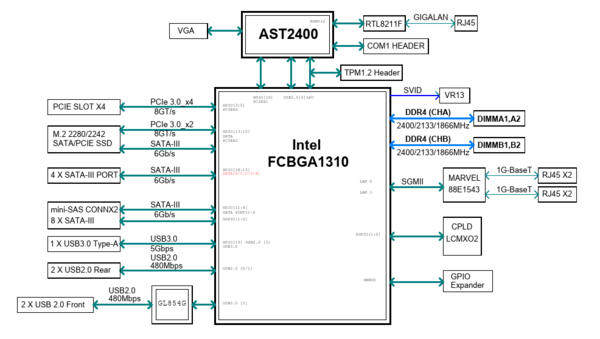« Hyperconverged Supermicro a2sdi-4c-hln4f » : différence entre les versions
mAucun résumé des modifications |
mAucun résumé des modifications |
||
| Ligne 1 : | Ligne 1 : | ||
This howto aims at describing the choices and the build of a compact homelab with a hyperconverged chassis based on a [https://www.supermicro.com/en/products/motherboard/A2SDi-4C-HLN4F Supermicro A2SDi-4C-HLN4F]. The hypervisor OS will be | This howto aims at describing the choices and the build of a compact homelab with a hyperconverged chassis based on a [https://www.supermicro.com/en/products/motherboard/A2SDi-4C-HLN4F Supermicro A2SDi-4C-HLN4F] motherboard. The hypervisor OS will be ''Slackware64-current'' (with ''Qemu/KVM'' for virtualization), the storage will be provided by a ''Truenas core'' VM (thanks to pci-passthrough) and network orchestrated by an ''OPNSense'' VM. | ||
== Motivations == | == Motivations == | ||
Why such a | Why such a motherboard with a modest 4 cores [https://ark.intel.com/content/www/us/en/ark/products/97937/intel-atom-processor-c3558-8m-cache-up-to-2-20-ghz.html Intel Atom C3558] ? | ||
Let's see the advantages : | Let's see the advantages : | ||
* obviously, it's very compact (mini-itx form factor) | * obviously, it's very compact (mini-itx form factor) | ||
| Ligne 26 : | Ligne 26 : | ||
* Hypervisor OS on RAID 1 with two drives | * Hypervisor OS on RAID 1 with two drives | ||
* 4 TB of encrypted data with a minimum of resilience (at least RAID 1 or RAID 5, RAID 10 or RAID 6 desired) | * 4 TB of encrypted data with a minimum of resilience (at least RAID 1 or RAID 5, RAID 10 or RAID 6 desired) | ||
* it is recommended not to exceed 80% of the capacity of a ZFS | * it is recommended not to exceed 80% of the capacity of a ZFS filesystem, so, for 4 TB of usable data, 5 TB of raw capacity is required | ||
* all disks easily accessible from the front of the chassis | * all disks easily accessible from the front of the chassis | ||
Choosing between 2.5 or 3.5 inches is not so easy. Obviously, for raw capacity over a gigabit network, 3.5 inches hard drives are unbeatable in terms of price. In France (as of march 2021), it costs ~ 80 euros for a 2 TB NAS 3.5 inches HDD ... Same price for a 1 TB NAS 2.5 inches HDD. Moreover, 2.5 inches HDD simply doesn't exist for consumer NAS systems (enterprise 2.5 inches HDD over 2 TB exist but are way too expensive). So, 3.5 inches drives ? But wait ... What about chassis size, cooling and noise ? | Choosing between 2.5 or 3.5 inches is not so easy. Obviously, for raw capacity over a gigabit network, 3.5 inches hard drives are unbeatable in terms of price. In France (as of march 2021), it costs ~ 80 euros for a 2 TB NAS 3.5 inches HDD ... Same price for a 1 TB NAS 2.5 inches HDD. Moreover, 2.5 inches HDD simply doesn't exist for consumer NAS systems (enterprise 2.5 inches HDD over 2 TB exist but are way too expensive). So, 3.5 inches drives ? But wait ... What about chassis size, cooling and noise ? | ||
Version du 30 mars 2021 à 20:56
This howto aims at describing the choices and the build of a compact homelab with a hyperconverged chassis based on a Supermicro A2SDi-4C-HLN4F motherboard. The hypervisor OS will be Slackware64-current (with Qemu/KVM for virtualization), the storage will be provided by a Truenas core VM (thanks to pci-passthrough) and network orchestrated by an OPNSense VM.
Motivations
Why such a motherboard with a modest 4 cores Intel Atom C3558 ? Let's see the advantages :
- obviously, it's very compact (mini-itx form factor)
- up to 256 GB ECC RDIMM RAM supported
- the CPU has a very low TDP (~ 17W), so no need for a fancy and potentially noisy cooling solution
- 4 * 1 Gb/s Ethernet ports (cool for a network appliance such as OPNSense and there's no need for 10 Gb/s for this project)
- dedicated IPMI Ethernet port
- the SATA ports are provided by two distinct PCIe lines (see below, very important for pci-passthrough and no need for an additionnal HBA card)
Well, the system has drawbacks too :
- the CPU power will not be extraordinary
- it's not possible to put a fan directly on top of the CPU heatsink (more on that later)
- no external USB 3.0 ports (ony one "internal", on the motherboard itself) ; this is desirable to plug an external HDD for local backups (USB 2.0 is too slow)
2.5 or 3.5 inches drives ?
What is required for this project :
- Hypervisor OS on RAID 1 with two drives
- 4 TB of encrypted data with a minimum of resilience (at least RAID 1 or RAID 5, RAID 10 or RAID 6 desired)
- it is recommended not to exceed 80% of the capacity of a ZFS filesystem, so, for 4 TB of usable data, 5 TB of raw capacity is required
- all disks easily accessible from the front of the chassis
Choosing between 2.5 or 3.5 inches is not so easy. Obviously, for raw capacity over a gigabit network, 3.5 inches hard drives are unbeatable in terms of price. In France (as of march 2021), it costs ~ 80 euros for a 2 TB NAS 3.5 inches HDD ... Same price for a 1 TB NAS 2.5 inches HDD. Moreover, 2.5 inches HDD simply doesn't exist for consumer NAS systems (enterprise 2.5 inches HDD over 2 TB exist but are way too expensive). So, 3.5 inches drives ? But wait ... What about chassis size, cooling and noise ?

